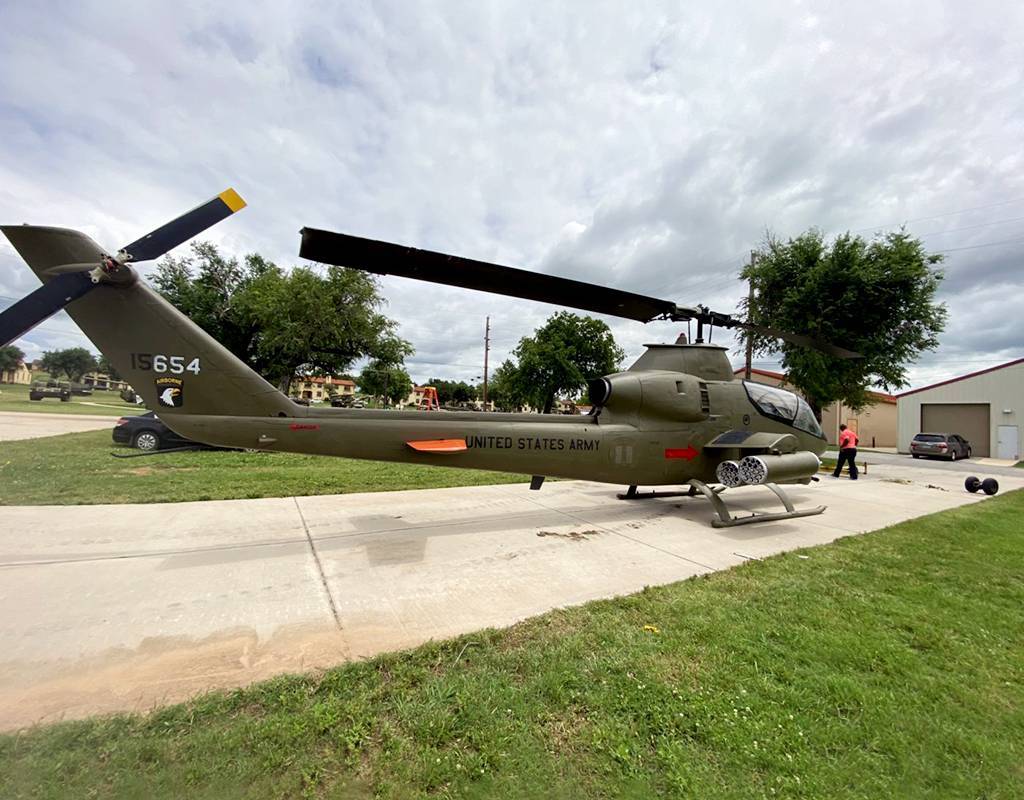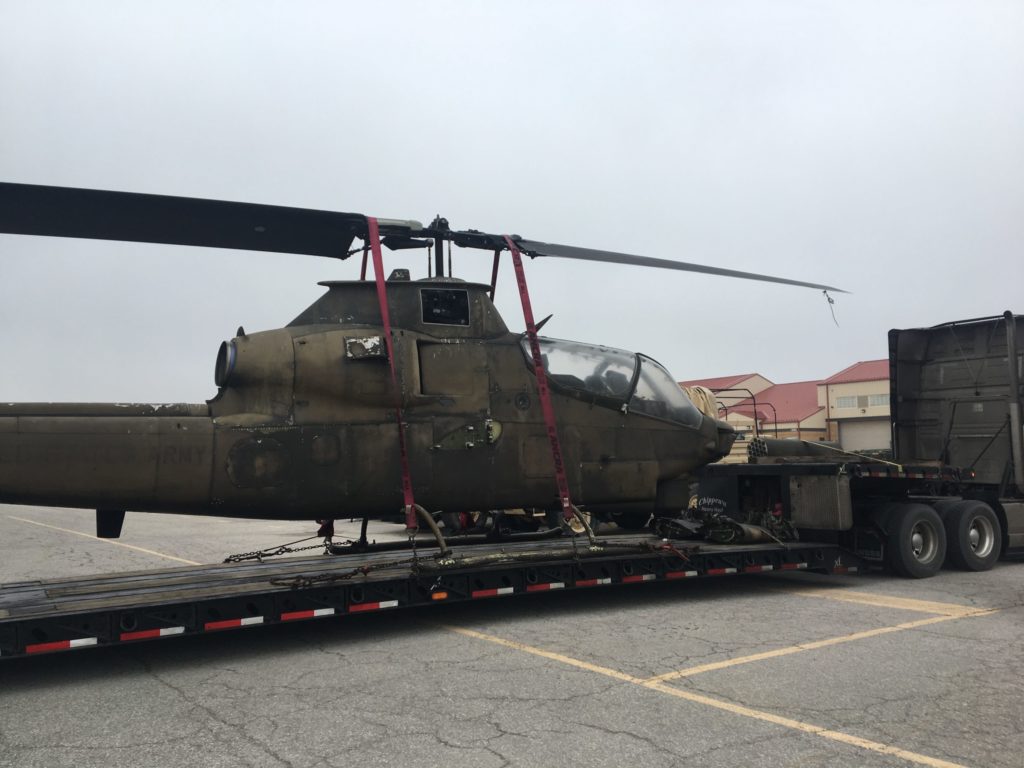
U.S. Army Cobra 15654 began its career with three years of combat during the Vietnam War, and almost ended its days in Minnesota with birds nesting in its engine compartment.
Now it has been fully restored to its original configuration as an aerial rocket artillery helicopter and found a new home with the folks who will care for it at the U.S. Army Field Artillery Museum at Fort Sill, Oklahoma.
Known as attack helicopters and the precursor to the AH-64 Apache, the AH-1 initially served the Army in aerial rocket artillery units providing close air support to troops on the ground in Vietnam, said Jon Bernstein, a Cobra historian and director of the Air Defense Artillery Museum at Fort Sill.
Advertisement
“Aerial rocket artillery was a very specific role and there were actually only three units that performed that mission through the entirety of the war,” said Bernstein. “Their main mission was support of troops on the ground. They weren’t like Cavalry where they use Cobras to seek and destroy the enemy and they weren’t like assault helicopter company Cobras, which were designed primarily to escort Hueys in and out of hot landing zones, although Cobras in ARA units did all that, as well. They were supposed to be on-call fire-support units for ground troops in contact.”
It was for this reason that Bernstein decided the artillery museum should have its own Cobra, so he went hunting for one in the collection of old vehicles and other artifacts the Army keeps from past conflicts. Artifacts on the so-called “de-accession” list typically end up at museums outside the government system or are reused by the Army for other purposes.
“I looked through the entire collection to see what Cobras were there and to see if any of them had aerial rocket artillery provenance and I came across this one, which was due to be de-accessioned,” Bernstein said. “I said, let’s grab this one while we can.”
Before arriving at Fort Sill, the helicopter lived outdoors at the Minnesota Air National Guard Museum in St. Paul, which was hoping to “get rid of it,” Bernstein said.

The 50-foot-long AH-1S Cobra attack helicopter arrived at the museum in March 2019 and has undergone extensive restoration by Bernstein and exhibits specialist Zane Mohler since. During the recent shutdown, Mohler had time to finish painting the entire fuselage in preparation for it being installed in the museum.
Entering service in 1966, the Bell AH-1 was a production model gunship for the U.S. Army, with one 1,400 shaft horsepower (1,000 kW) Avco Lycoming T53-13 turboshaft engine and shared fuselage commonalities with the UH-1 Huey.
This particular Cobra was flown by A Battery, 4th Battalion, 77th Aerial Rocket Artillery (ARA) in Vietnam and Laos from December 1970 to March 1971, when it was blown up during a sapper attack on the Marine Corps fire base at Khe Sanh.
“I started digging a little deeper and we actually were able to find video of it at Khe Sanh on the morning after the sapper attack,” Bernstein said. “You can clearly see all the damage to the tail boom and other things.”
The helicopter then went back to manufacturer Bell for a rebuild, after which its operational history becomes “a little fuzzy,” Bernstein said. It might have been rebuilt as a G-model at that point or as an AH-1Q, which introduced the M65 tube-launched, optically tracked, wire-guided (TOW)/Cobra missile subsystem, M65 telescopic sight unit (TSU), and M73 reflex sight. It was those sighting systems that sat in the nose turret the aircraft sported when it arrived in Oklahoma.
In any case, by the late 1970s the helicopter was sporting new 1,800 shp (1,300 kW) T53-L-703 turboshaft engine that classified it as a baseline AH-1S, Bernstein said. It flew with the Minnesota National Guard for an unspecified amount of time before being demilitarized and placed on static display outside the museum in St. Paul.
“It was in rough shape,” Bernstein said. “It had been outside for years. There were 18-inch deep bird nests in the engine compartment.”
It went into the museum workshop in December 2019 to emerge during the Covid-19 lockdown and will be installed atop its piling in the coming weeks as the museum prepares to reopen.

Advertisement
“Pretty much from December through [May 27] we’ve been working on it, of course with the quarantine and everything, Zane [Mohler] has been the only person in the exhibit shop and he was able to get the entire thing painted and stenciled during those two months.”
Before that, the pair had to remove all the anachronistic add-ons of its later service, including wire-strike protection devices, and replace the tail rotor and tail rotor gearbox. They also had to replace the AH-1S nose housing, which features the later addition of a swivelling turret.
Bernstein was able to track down an older, smoother AH-1J nose to backdate the helicopter to its aerial artillery days in Vietnam. But when the helicopter had its nose job in the 1970s, one of the forward fuselage bulkhead was widened to accept the new turret. Those had to be narrowed by about 1.5 inches in order to accept the older nose.
“It was more involved than I thought it was going to be, but definitely a challenging and rewarding experience,” Bernstein said.
Much of the credit goes to Mohler, Berstein said. As the lone person with access to the museum shop during the shutdown, Mohler continued the work. He was able to hand-build four “impossible to come by” M200 rocket pods by borrowing the real deal from the Army Aviation Museum at Fort Rucker, Alabama, and copying it using PVC pipe, plexiglass and sheet metal.
Mohler also had to build proper pylon fairing from scratch by molding fiberglass using original technical drawings and Vietnam-era photos.
For Bernstien, a former Apache pilot, returning this Cobra to its aerial artillery roots is a complete circle. After the battle of An Loc in 1972, the Army realized that helicopters could kill tanks, Bernstein said. For the past two decades, the Apaches he flew as tank killers have been performing air support for troops in Afghanistan and Iraq.
“The Army shifted focus from a fire-support platform to a tank killer and that’s how the Apache evolved,” Berstein said. “And now, the Apache now has been doing a very similar role to what the ARA Cobras did in Vietnam.”



